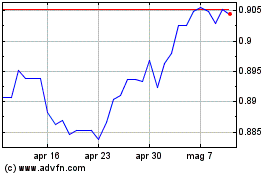Antipodean Currencies Slide Amid Risk Aversion
16 Ottobre 2024 - 3:43AM
RTTF2
The Antipodean currencies such as the Australia and the New
Zealand dollars weakened against their major currencies in the
Asian session on Wednesday amidst risk aversion, as some traders
looked to cash in on recent strength in the markets and booked some
profits. The rising tensions in the Middle East and reports about
China's extensive drills around Taiwan are also hurting market
sentiment.
On the interest rate front, while hopes the U.S. Fed will lower
rates by another 50 basis points next month have largely
evaporated, optimism the central bank will cut rates by 25 basis
points remains.
CME Group's FedWatch Tool is currently indicating a 92.2 percent
chance the Fed will cut rates by a quarter point at its November
meeting.
Crude oil prices fell sharply as fears about supply disruptions
faded on reports that Israel will avoid targeting Iran's oil sites.
West Texas Intermediate crude oil futures for November sank $3.25
or 4.4 percent at $70.58 a barrel.
Additionally, the NZ dollar weakened against its major
counterparts following the release of nation's inflation data,
falling within the RBNZ target range of 1% to 3%.
Data from Statistics New Zealand showed that the consumer prices
in New Zealand were up 2.2 percent on year in the third quarter of
2024, in line with expectations and down from 3.3 percent in the
previous three months.
On a seasonally adjusted quarterly basis, inflation rose 0.6
percent, shy of expectations for 0.7 percent and up from 0.4
percent in the three months prior.
In the Asian trading today, the Australian dollar fell to 8-day
lows of 1.6320 against the euro and 99.44 against the yen, from
yesterday's closing quotes of 1.6242 and 99.99, respectively. If
the aussie extends its downtrend, it is likely to find support
around 1.65 against the euro and 97.00 against the yen.
Against the U.S. and the Canadian dollars, the aussie slipped to
more than a 1-month low of 0.6668 and a 1-week low of 0.9194 from
Tuesday's closing quotes of 0.6702 and 0.9231, respectively. The
aussie may test support near 0.65 against the greenback and 0.90
against the loonie.
The NZ dollar fell to nearly a 2-month low of 0.6040 against the
U.S. dollar, a 2-week low of 90.07 against the yen and a 6-day low
of 1.8018 against the euro, from yesterday's closing quotes of
0.6082, 90.74 and 1.7899, respectively. If the kiwi extends its
downtrend, it is likely to find support around 0.59 against the
greenback, 87.00 against the yen and 1.82 against the euro.
Against the Australian dollar, the kiwi edged down to 1.1049
from Tuesday's closing value of 1.1016. The next possible downside
target for the kiwi is seen around the 1.11 region.
Looking ahead, U.S. MBA mortgage approvals data, Canada housing
starts for September, manufacturing sales data for August, U.S.
import and export prices for September, are slated for release in
the New York session.
Grafico Cross AUD vs CAD (FX:AUDCAD)
Da Ott 2024 a Nov 2024

Grafico Cross AUD vs CAD (FX:AUDCAD)
Da Nov 2023 a Nov 2024
